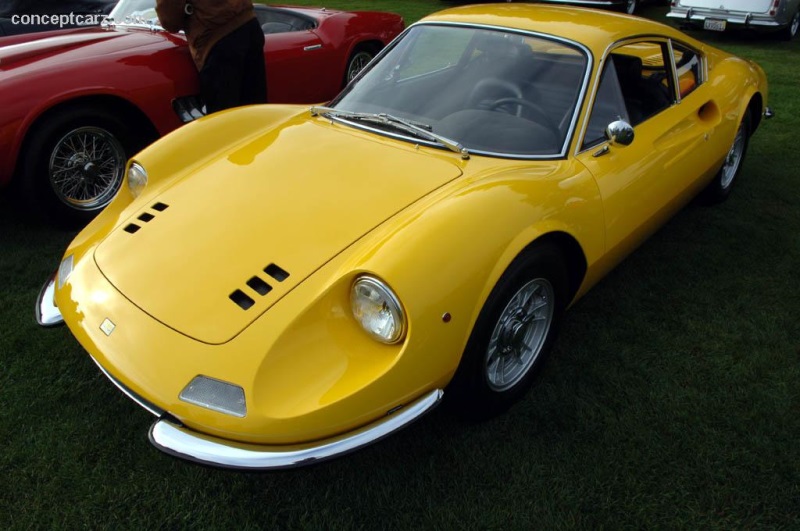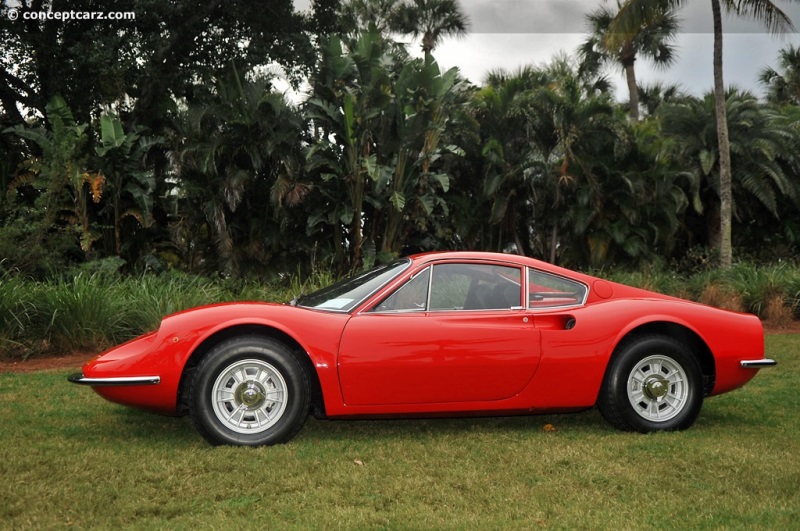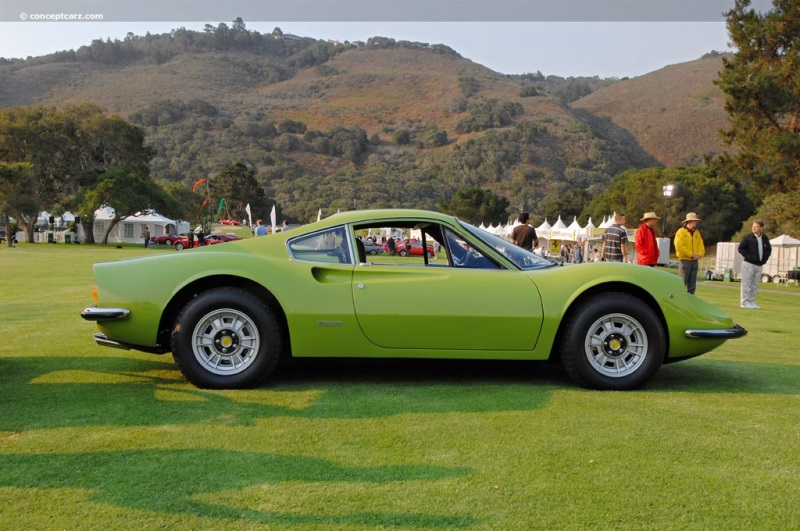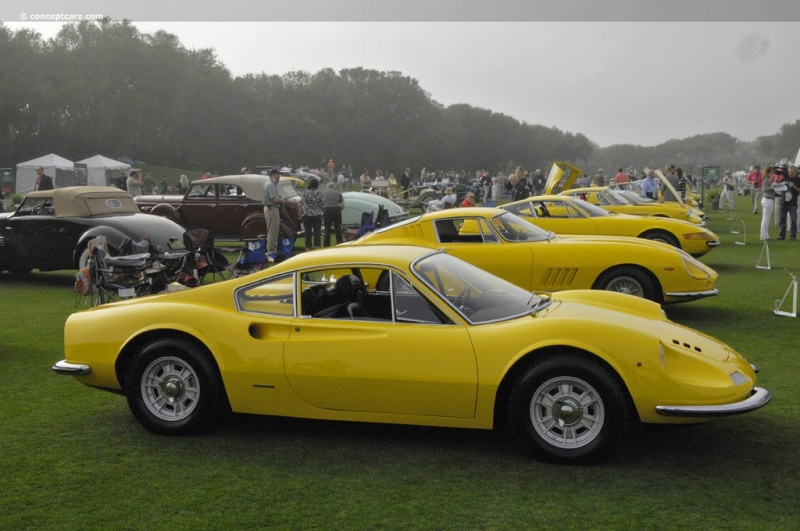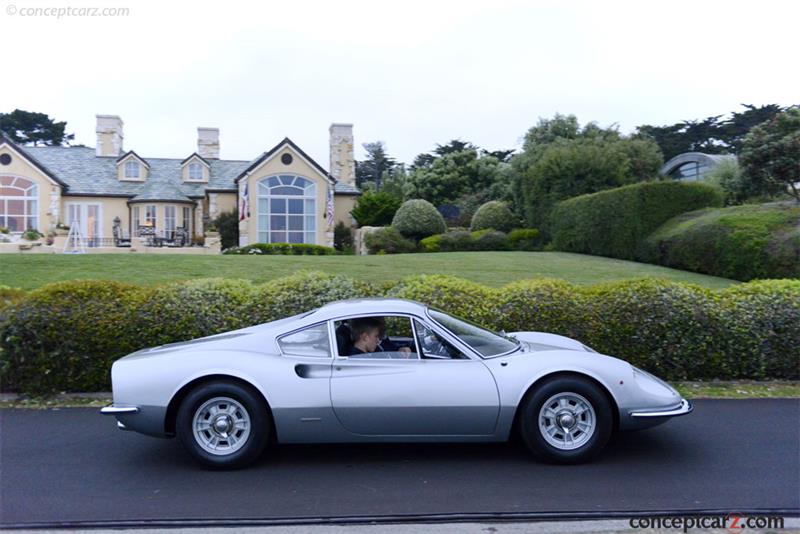The 'Dino' sports car was named in honor of Enzo Ferrari's late son Alfredino, and was inspired by Ferrari's V-6 racing-engine development program of the 1950s and 1960s. The Vittorio Jano-engineered 'Dino' V-6 powered Ferrari to its first Grand Prix Manufacturer's Championship and team driver Mike Hawthorn to the driver's title in 1958.
With the upcoming 1960 Formula 2 season and the 1.5-liter Formula 1 displacement limit announced for 1961, Enzo Ferrari tasked his technical director Carlo Chiti with updating the 'Dino' V-6 engine and placing it in a new car with the engine mounted behind the driver. The resulting 156 'Sharknose' driven by American Phil Hill clinched the 1961 Manufacturer's and Driver's championship for Ferrari and Hill at Monza.
The 'Dino' V-6 design had proven competitive in Formula 2, however revisions to FISA (Fédération Internationale du Sport Automobile) Formula 2 rules required a production-based engine and a 500-unit homologation requirement to compete beginning in 1967. Since Ferrari was a low-volume manufacturer and lacked the production capacity to meet this limit, they initially courted Ford (ultimately leading to the infamous 'Ford versus Ferrari' rivalry) before settling with the Italian industrial giant FIAT. FIAT produced the Ferrari-designed 2.0-liter, V-6 engine which powered FIAT's Pininfarina-built Dino Spyder debuting for 1966 and the Bertone-bodied Dino coupe from 1967.
Ferrari's V-6 line of road cars was an evolution of Pininfarina's 'Dino 206 S Speciale,' a styling exercise first shown at the 1965 Paris Salon. At Turin the following year, the 'Dino Berlinetta GT' first appeared, powered by a transverse mid-mounted V-6 engine and clothed with a Pininfarina-designed body built by Scaglietti. The first production Dino, designated 206 GT (denoting 2.0 litres of engine displacement and six cylinders) debuted in Turin in 1967, and was the first mid-engine production car by Ferrari and the start of the new Ferrari-based 'Dino' brand. In total, 150 examples were produced.
The 246 GT arrived in 1969, with the new model officially launched at the November Turin Salon that year, although production had already begun by then. The outward appearance was nearly identical to the prior 206 GT, except that the fuel filler car was now located under a flush-fitting flat on the car's left sail panel. The wheelbase and overall length increased slightly, allowing movement of the rear bulkhead further aft yielding additional interior room. Steel was now used for the main body panels and the engine block, replacing the prior aluminum components.
The enlarged 2,418cc engine resulted in a boost of power by 35 horsepower, giving the 246 GT a 140-plus mph top speed. Zero-to-sixty mph was accomplished in the seven-second range. By the time production ceased in 1974, nearly 2,500 examples were built along three series marked by a number of changes including 'L' for Lungo (Long Wheelbase), 'M' for Modificato (Modified Chassis), and 'E' for Evoluzione.
At the March 1972 Geneva Salon, Ferrari introduced the 246 GTS with its black-finished removable roof panel and the elimination of the 246 GT Berlinetta's rear quarter windows. Production of the 246 GTS, part of the Series 'E' or Evoluzione run, was built through July 1974 with 1,274 produced. It incorporated all updates applied to the prior 'M' Series, with further modifications to the five-speed gearbox and engine. Detail changes included the relocation of the door locks, wider quarter-bumpers, windshield-wiper parking on left-hand drive cars, chrome-plated rectangular license-plate frame at the rear, and a switch to circular frontal cooling ducts.
The US-market 246 GT appeared near the end of 1971, followed by the 246 GTS with both models equipped with DOT-compliant front-signal and side-marker lamps.
The Dino was not as fast in a straight line as its larger V-12 engined stablemate, however, its small footprint, nimble handling characteristics, and lightweight construction made it a formidable competitor on the twisty circuits. A Ferrari 246 GT did contest the 24 Hours of LeMans in 1972. The highly modified example, based on chassis 02678, was entered by Luigi Chinetti's North American Racing Team (N.A.R.T.) and piloted by Gilles Doncieux, Pierre Laffeach, and Yves Forestier to a 17th overall and 7th in the Index of Performance.
by Daniel Vaughan | Apr 2020
With the upcoming 1960 Formula 2 season and the 1.5-liter Formula 1 displacement limit announced for 1961, Enzo Ferrari tasked his technical director Carlo Chiti with updating the 'Dino' V-6 engine and placing it in a new car with the engine mounted behind the driver. The resulting 156 'Sharknose' driven by American Phil Hill clinched the 1961 Manufacturer's and Driver's championship for Ferrari and Hill at Monza.
The 'Dino' V-6 design had proven competitive in Formula 2, however revisions to FISA (Fédération Internationale du Sport Automobile) Formula 2 rules required a production-based engine and a 500-unit homologation requirement to compete beginning in 1967. Since Ferrari was a low-volume manufacturer and lacked the production capacity to meet this limit, they initially courted Ford (ultimately leading to the infamous 'Ford versus Ferrari' rivalry) before settling with the Italian industrial giant FIAT. FIAT produced the Ferrari-designed 2.0-liter, V-6 engine which powered FIAT's Pininfarina-built Dino Spyder debuting for 1966 and the Bertone-bodied Dino coupe from 1967.
Ferrari's V-6 line of road cars was an evolution of Pininfarina's 'Dino 206 S Speciale,' a styling exercise first shown at the 1965 Paris Salon. At Turin the following year, the 'Dino Berlinetta GT' first appeared, powered by a transverse mid-mounted V-6 engine and clothed with a Pininfarina-designed body built by Scaglietti. The first production Dino, designated 206 GT (denoting 2.0 litres of engine displacement and six cylinders) debuted in Turin in 1967, and was the first mid-engine production car by Ferrari and the start of the new Ferrari-based 'Dino' brand. In total, 150 examples were produced.
The 246 GT arrived in 1969, with the new model officially launched at the November Turin Salon that year, although production had already begun by then. The outward appearance was nearly identical to the prior 206 GT, except that the fuel filler car was now located under a flush-fitting flat on the car's left sail panel. The wheelbase and overall length increased slightly, allowing movement of the rear bulkhead further aft yielding additional interior room. Steel was now used for the main body panels and the engine block, replacing the prior aluminum components.
The enlarged 2,418cc engine resulted in a boost of power by 35 horsepower, giving the 246 GT a 140-plus mph top speed. Zero-to-sixty mph was accomplished in the seven-second range. By the time production ceased in 1974, nearly 2,500 examples were built along three series marked by a number of changes including 'L' for Lungo (Long Wheelbase), 'M' for Modificato (Modified Chassis), and 'E' for Evoluzione.
At the March 1972 Geneva Salon, Ferrari introduced the 246 GTS with its black-finished removable roof panel and the elimination of the 246 GT Berlinetta's rear quarter windows. Production of the 246 GTS, part of the Series 'E' or Evoluzione run, was built through July 1974 with 1,274 produced. It incorporated all updates applied to the prior 'M' Series, with further modifications to the five-speed gearbox and engine. Detail changes included the relocation of the door locks, wider quarter-bumpers, windshield-wiper parking on left-hand drive cars, chrome-plated rectangular license-plate frame at the rear, and a switch to circular frontal cooling ducts.
The US-market 246 GT appeared near the end of 1971, followed by the 246 GTS with both models equipped with DOT-compliant front-signal and side-marker lamps.
The Dino was not as fast in a straight line as its larger V-12 engined stablemate, however, its small footprint, nimble handling characteristics, and lightweight construction made it a formidable competitor on the twisty circuits. A Ferrari 246 GT did contest the 24 Hours of LeMans in 1972. The highly modified example, based on chassis 02678, was entered by Luigi Chinetti's North American Racing Team (N.A.R.T.) and piloted by Gilles Doncieux, Pierre Laffeach, and Yves Forestier to a 17th overall and 7th in the Index of Performance.
by Daniel Vaughan | Apr 2020
Related Reading : Ferrari Dino History
The 206 Dino was built by Enzo Ferrari as a tribute to his son who passed away in 1956 at the age of 24 due to kidney disease. Alfredo Ferrari, more commonly known as Dino, was Enzo Ferraris only son (Alfredo was also Enzos brother and fathers name). Afredo had been trained in Switzerland as an engineer, after which he returned to the family business and received tutoring from his father. It was....
Continue Reading >>
Continue Reading >>
Similar Automakers
Similarly Sized Vehicles
from 1970
1970 Ferrari Dino 246 GT Vehicle Profiles
Recent Vehicle Additions
Performance and Specification Comparison
Dino 246 Specification Comparison by Year
Year
Production
Wheelbase
Engine
Prices
Related Automotive News

Where it all started: Enzo's first production model heads up incomparable set of Maranello greats as Salon Privé celebrates Ferrari's 75th anniversary
Salon Privé Concours dElégance presented by Aviva assembles rare and hallowed Ferrari models, the like of which has never been seen before at a UK Concours
Notables include 1947 125 S (first production Ferrari ever built, on loan from factory),...

Phenomenal Ferraris and Italian Thoroughbreds Offered at Gooding & Company's Pebble Beach Auctions
The auction house announced a stable of Italian star cars, including a 1950 Ferrari 166 MM Berlinetta Le Mans, a 1961 Ferrari 400 Superamerica Series I Coupe Aerodinamico, and a 1954 Ferrari 500 Mondial Series I Spider.
A stunning group of star...

Ferrari: Under The Skin
15 November 2017 - 15 April 2018
Major exhibition announced by the Design Museum in London to mark the 70th anniversary of Ferrari
£140M worth of Ferraris featured in exhibition displaying cars driven by racing drivers Peter Collins and Stir...

From Russo With Love! Ferrari with 007 Pedigree to Cross the Block at Russo and Steele Monterey!
1970 Ferrari 365 22 with 007 Pedigree Set to Cross the Block at Russo and Steeles 16th Annual Monterey Collector Automobile Auction Event!
Scottsdale, Arizona (June 24th, 2016) – First shown at Paris in 1967, the 365 GT 22 took place...

H&H CLASSICS TO SELL TWO MULTI-MILLION FERRARIS IN GENEROUS LEGACY TO THE RNLI
H%26H Classics to offer a 1960 Ferrari 250 GT SWB and 1967 Ferrari 275 GTB4 from the estate of the late Richard Colton, a pre-eminent British V12 Ferrari collector
Proceeds from the sale to benefit the Royal National Lifeboat Institution
1960 Ferra...
























